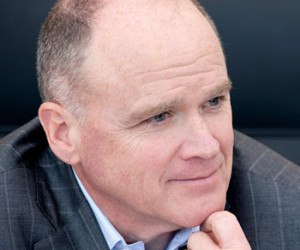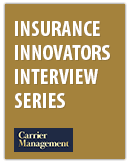This article is part of our insurance innovators interview series.
 Stanley A. Galanski, President and CEO, The Navigators Group, Inc.
Stanley A. Galanski, President and CEO, The Navigators Group, Inc. Mark E. Watson III, President and Chief Executive Officer, Argo Group International Holdings, Ltd.
Mark E. Watson III, President and Chief Executive Officer, Argo Group International Holdings, Ltd. Kevin H. Kelley, Chief Executive Officer, Ironshore Inc.
Kevin H. Kelley, Chief Executive Officer, Ironshore Inc. John Wurzler, President, OneBeacon Technology Insurance
John Wurzler, President, OneBeacon Technology Insurance Alan B. Colberg, President and Chief Executive Officer, Assurant, Inc.
Alan B. Colberg, President and Chief Executive Officer, Assurant, Inc. Manny Rios, President and CEO, American Modern Insurance Group
Manny Rios, President and CEO, American Modern Insurance Group Dave Pratt, General Manager, Usage-Based Insurance, Progressive
Dave Pratt, General Manager, Usage-Based Insurance, Progressive Berto Sciolla, EVP and Manager of North American Treaty Reinsurance,Gen Re
Berto Sciolla, EVP and Manager of North American Treaty Reinsurance,Gen Re Greg Hendrick, Chief Executive, Insurance, XL Catlin
Greg Hendrick, Chief Executive, Insurance, XL Catlin Anand Rao, Principal, PwC U.S. Advisory Practice
Anand Rao, Principal, PwC U.S. Advisory Practice Mike McGavick, Chief Executive Officer, XL Catlin
Mike McGavick, Chief Executive Officer, XL Catlin David M. Lightfoot, Managing Director, Head of GC Analytics – Americas, Guy Carpenter
David M. Lightfoot, Managing Director, Head of GC Analytics – Americas, Guy Carpenter Conan Ward, Chief Executive Officer, Hamilton USA
Conan Ward, Chief Executive Officer, Hamilton USA Ming Lee, Chief Executive Officer, AIR Worldwide
Ming Lee, Chief Executive Officer, AIR Worldwide Laura Hay, National Insurance Sector Leader, KPMG LLP
Laura Hay, National Insurance Sector Leader, KPMG LLP John Lupica, Vice Chairman, ACE Group; Chairman, Insurance–North America
John Lupica, Vice Chairman, ACE Group; Chairman, Insurance–North America
 Mark E. Watson III, President and Chief Executive Officer, Argo Group International Holdings, Ltd.
Mark E. Watson III, President and Chief Executive Officer, Argo Group International Holdings, Ltd.Q1: In your view, what has been the greatest innovation in the P/C insurance industry in recent years? Explain.
Watson (Argo): I don’t think there is a single game-changer that stands out from the rest. But that will change—and soon. We are in the midst of a digital/customer-driven interaction movement that is already beginning to reshape our industry, our distribution models, our business processes, and our products and services. To stay relevant and viable over the long term, insurers can choose to invest in digital technologies or digitize their entire business, or do both.
Bottom line: An ongoing commitment to innovation is just one of many requisites to maintaining a strong position in today’s value chain. The greatest innovations are coming—and soon.
Q2: Describe the greatest innovation at your company during your tenure. (It could be a product, process or service). How did it come about? (Feel free to describe more than one.)
Watson (Argo): The contribution I am most proud of is our business strategy and our people. It’s our secret sauce.
As a company, we’ve always maintained a long-term view—the backbone to securing the future for our customers, business partners and employees. In doing so, we employ a formidable dose of selectivity when making decisions on the risks we underwrite, regions we plant new flags in and investments we make.
This strategy also extends across the business in the companies we acquire, talent we hire, and the products and services we deliver to the marketplace. During the past decade, it has helped us grow our capital from a few hundred million to more than $2 billion and more than triple shareholder value. It has enabled us to transform from a workers compensation provider to one of the leading global underwriters of specialty insurance and reinsurance.
Q3: In your view, what innovation or innovator outside the insurance industry has had or is having the greatest impact on the P/C insurance industry?
Watson (Argo): With the rise and popularity of the Internet of Things (IoT) movement, we already are starting to see this trend of industry “outsiders,” like Google and IBM, making their way into the insurance space.
Again, it goes back to this notion of customer-driven interaction. While insurers may be experts in underwriting, claims and risk management, the customer preference piece is the key to survival in the new operating normal. Naturally, for insurers, this evolution will catalyze a boom of technological investments, strategic partnerships and other moves to integrate digital into their business and leverage it for their strategic advantage.
Q4: Describe one or more ways in which your company encourages innovation. (Feel free to describe any elements of the culture or process.)
Mark Watson, Argo Group
Watson (Argo): Though “innovation” is a buzzword that gets kicked around a lot, at Argo Group it’s one of our core values. We invest a lot of energy in promoting a culture of curiosity, creativity and community. This really is appealing to the high-performers we invite to join us on our journey. When they arrive at Argo Group, it doesn’t take long for them to realize the opportunity. We recognize that no matter what your role is in the organization, everyone has a hidden gem of an idea just waiting to be discovered.
To facilitate such discovery, we have a business unit dedicated solely to innovation and the research and development around it. The team’s charge is to explore new possibilities, leverage emerging technologies and engage our amazing talent to help drive the spirit of innovation throughout the organization. The group is constantly refining the new product development process, launching ideation campaigns and championing an inclusive corporate culture to ensure our business is constantly evolving.
Q5: What is the biggest obstacle to innovation within the insurance industry? Explain. What is your company doing (or what can the industry do) to overcome this obstacle?
Watson (Argo): Insurers are a fickle bunch. We are inherently risk averse, and for good reason. But to be truly innovative involves taking risk. There’s that traditional threshold of what is and what isn’t acceptable, but regardless of an insurer’s risk appetite, we need to embrace a level of uncertainty we may not be terribly comfortable with. Now more than ever, we need to challenge the status quo with an open and inquisitive mind. We must start rethinking everything to respond to change effectively for our customers and ourselves.
Q6: Do you believe the next innovation to impact the P/C insurance industry will come from inside the industry or from an external innovator? Why?
Watson (Argo): On one hand, insurers have the advantage because we are experts in our craft. That’s something technology companies cannot compete with. But technology providers have the client focus and expertise carriers need.
I don’t think it’s a matter of who—insurance or technology—will win the battle. Winners will be evaluated on the merits of their ability and the speed with which they can marry these two worlds and change the game.
Q7: Describe your role in leading innovation at your company.
Watson (Argo): At Argo Group, we really pride ourselves on fostering an environment of innovation. Like many CEOs, I wear a number of hats. Part of my mission is to ensure the spirit of innovation is cultivated so it can thrive.
As chief entrepreneur, I have the privilege of setting the tone of innovation throughout the organization. Anyone who knows me knows that I am passionate about innovation, and I try to make that known. I assume the task of setting the example, so my leadership team can follow and do likewise. In this light, it is important to convey to others that some disruption is not only okay but is encouraged. We need different perspectives to grow. We need to execute well and remember that failure is just part of the learning process. We need change agents that will champion our cause and keep our business evolving. It all comes down to collaboration, commitment and communication. These are the parts of our innovation engine that fuel success and keep the wheels spinning.
Q8: What is the best book you have read about innovation? The best course or seminar you have attended? What was a key takeaway from the book or education session?
Watson (Argo): There really are many great books written on the subject of innovation. Something I rediscovered recently resonated with me. It wasn’t a book but an article in HBR titled “The Ambidextrous CEO.” There’s a quote in there about innovation’s “only friend” being the CEO. It’s about managing the tension between the need for resources of the core business and the need to allocate resources to build future businesses.
In many organizations it can be true that innovation becomes solely owned by the CEO. I set out many years ago to make sure that never happens in our company. Innovation at Argo is a shared responsibility at the executive level, and we are rapidly pushing that ownership right through the organization. It does remain my job to manage the tension, but we see that as a positive, not a negative, as it means we are creating new opportunity. The need to take from this quarter’s bottom line to generate something much greater in eight quarters is understood across our leadership.
Q9: It is often said that tolerance for failure is one of the key cultural elements of a company in which innovation can thrive. Describe a failed initiative at your company and what you learned about innovation in the process.
Watson (Argo): We had a great product that offered insurance for small-business bank accounts. The coverage protected them against thefts via phishing, malware and other cyber attacks. In all aspects, it showed significant promise. But to have success in launching a product, even a winner takes a combination of innovations—in areas such as distribution techniques, marketing options, pricing, etc. We relied too heavily on some traditional methods in those areas when we introduced the product. In the end, the key takeaway for us was that innovation has to be part of the entire offering—not just the product.
Q10: Have you ever collaborated with market competitors to move an innovation forward? If so, why did collaboration make sense in this situation?
Watson (Argo): We have collaborated with business partners in the past and continue to find value in forming strategic partnerships that support our business goals. For example, in one case, we designed a new product and our competitor/business partner (a reinsurer) assumed the risk. With this particular product, we already had a sizable investment risk out there, so the combination proved to be mutually beneficial and profitable.
Q11: Outside of providing risk transfer solutions, what are the most likely areas in which insurers can be innovators? Can P/C insurers disrupt other industries or provide noninsurance solutions by applying innovations developed through their core skills in underwriting and risk analysis, settlement negotiations, catastrophe modeling, environmental science or other areas?
Watson (Argo): This is a truly exciting time for the insurance industry. The digital revolution we find ourselves in will enable a cross-pollination of core skills and capabilities across industries and sectors that can drive new opportunities for commerce to thrive. At the center of it all will be our customer. In the new socialized economy, the customer has earned the right to place increasing demands on insurers and other service providers. They want transparency. Let’s find ways to deepen trust. They want connection. Let’s find ways to fortify relevancy. They want simplicity. Let’s find ways to integrate technology. Let’s find ways to deliver the experience they deserve.
Read more Innovation Insights by Person:
 Stanley A. Galanski, President and CEO, The Navigators Group, Inc.
Stanley A. Galanski, President and CEO, The Navigators Group, Inc. Mark E. Watson III, President and Chief Executive Officer, Argo Group International Holdings, Ltd.
Mark E. Watson III, President and Chief Executive Officer, Argo Group International Holdings, Ltd. Kevin H. Kelley, Chief Executive Officer, Ironshore Inc.
Kevin H. Kelley, Chief Executive Officer, Ironshore Inc. John Wurzler, President, OneBeacon Technology Insurance
John Wurzler, President, OneBeacon Technology Insurance Alan B. Colberg, President and Chief Executive Officer, Assurant, Inc.
Alan B. Colberg, President and Chief Executive Officer, Assurant, Inc. Manny Rios, President and CEO, American Modern Insurance Group
Manny Rios, President and CEO, American Modern Insurance Group Dave Pratt, General Manager, Usage-Based Insurance, Progressive
Dave Pratt, General Manager, Usage-Based Insurance, Progressive Berto Sciolla, EVP and Manager of North American Treaty Reinsurance,Gen Re
Berto Sciolla, EVP and Manager of North American Treaty Reinsurance,Gen Re Greg Hendrick, Chief Executive, Insurance, XL Catlin
Greg Hendrick, Chief Executive, Insurance, XL Catlin Anand Rao, Principal, PwC U.S. Advisory Practice
Anand Rao, Principal, PwC U.S. Advisory Practice Mike McGavick, Chief Executive Officer, XL Catlin
Mike McGavick, Chief Executive Officer, XL Catlin David M. Lightfoot, Managing Director, Head of GC Analytics – Americas, Guy Carpenter
David M. Lightfoot, Managing Director, Head of GC Analytics – Americas, Guy Carpenter Conan Ward, Chief Executive Officer, Hamilton USA
Conan Ward, Chief Executive Officer, Hamilton USA Ming Lee, Chief Executive Officer, AIR Worldwide
Ming Lee, Chief Executive Officer, AIR Worldwide Laura Hay, National Insurance Sector Leader, KPMG LLP
Laura Hay, National Insurance Sector Leader, KPMG LLP John Lupica, Vice Chairman, ACE Group; Chairman, Insurance–North America
John Lupica, Vice Chairman, ACE Group; Chairman, Insurance–North America
Read other innovator’s response by question:
- Q1: The greatest innovation in the P/C insurance industry
- Q2: Describe the greatest innovation at your company
- Q3: Innovation or innovator outside the insurance industry
- Q4: How your company encourages innovation
- Q5: The biggest obstacle to innovation within the insurance industry?
- Q6: The next innovation to impact the P/C insurance industry
- Q7: Your role in leading innovation.
- Q8: Best book you have read about innovation
- Q9: Describe a failed initiative at your company
- Q10: Collaborating with market competitors
- Q11: Can P/C insurers disrupt other industries?
Get all 16 interview neatly packaged in a single PDF download. Explore ideas by personality and by question. More than 60 pages of content.





















 Lemonade: 700K Customers on the Car Waitlist
Lemonade: 700K Customers on the Car Waitlist  Roof Repair and Replacement Costs Up Nearly 30% Since 2022: Verisk
Roof Repair and Replacement Costs Up Nearly 30% Since 2022: Verisk  Poor Background Music Choices Can Negatively Impact Work Performance
Poor Background Music Choices Can Negatively Impact Work Performance  USDA Opens 59% of Federal Forest for Logging to Manage Wildfire Risk
USDA Opens 59% of Federal Forest for Logging to Manage Wildfire Risk 



